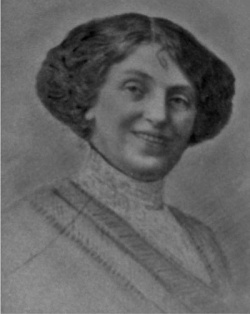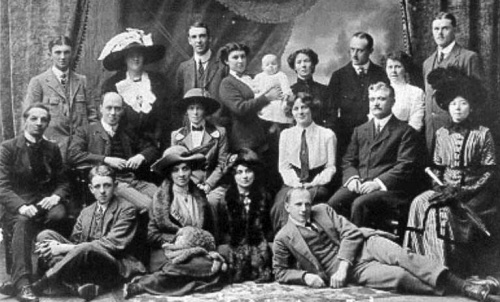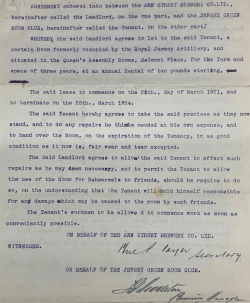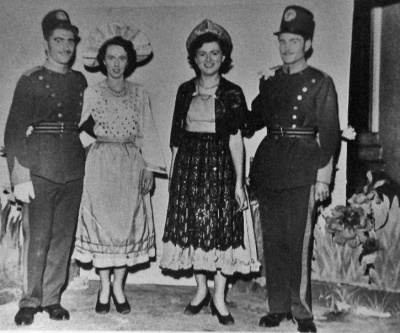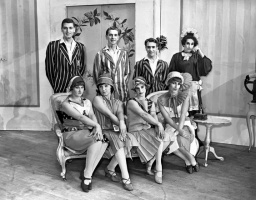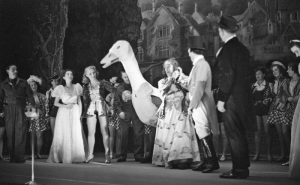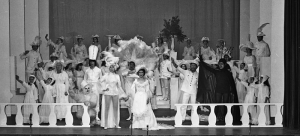The Jersey Green Room Club was instigated by Miss B M Peyton, Hamlyn Noel and Walter de L Devereux. They gathered together like minded people interested in ‘Dramatic Performance’ at Miss Peyton’s home at 1 Peel Terrace, St Helier on 11 September 1909, when all founders were present, except Mr Noel who was out of the island.
The founders were:
- Miss B.M. Peyton
- The Dean of Jersey, Samuel Falle
- Colonel Bond
- Major de Visne
- Captain C Blandy
- Captain R Richmond Raymer
- E Le Sueur
- Walter de L Devereux
- Jack Peyton (Secretary)
- Hamlyn Noel
The Dean was unanimously voted to the chair and various propositions were made and accepted.
Membership by ballot
It was decided that the club would be open to ladies and gentlemen of the island of Jersey who would be elected by ballot at committee meetings. One black ball would exclude the candidate and each candidate had to be personally known by both the proposer and the seconder.
The club would give two performances each season, in November and February in St Helier, and anywhere else in the island of the which the majority of the committee approved ie Bazaars, Charities etc.
The annual subscription was set at 10s 6d (52½p) for ladies, which will entitle them to one seat at each of the club’s two performances during the season in St Helier.
Various other rules were suggested and the meeting closed with the proposition that invitations be issued to interested parties to attend an inaugural meeting at Napier Hall, Nelson Street, St Helier on Monday 20 September 1909.
From this meeting the formation of the club took place at which 26 attended to become the original members of the Jersey Green Room Club. Miss Peyton was made President of the club, a position she held until her death in 1925.
Rich history
So began the rich history of the major amateur dramatic club of the island of Jersey. They tackled every form of theatrical presentation: plays - musicals, operetta, Gilbert and Sullivan, revues, cabaret and pantomimes.
The club’s first production was The Passport, which opened at the Opera House on 4 February 1910 and appears to have been an artistic, even if not a financial success. Included in the cast was Mr A M Coutanche, who was to become Sir Alexander Countanche, Bailiff of Jersey.
November 1910 saw the first musical production, an adaptation by Miss Peyton of a French comic opera and renamed Les Mousquetaires du Roi, at the Oddfellows’ Hall, Don Street. The production ran for three nights and one matinee. Mr M Brunt, the bandmaster of The Kings at the time, was musical director, a position he was to fill until 1935. The show was a great success.
The first Savoy Opera to be produced was HMS Pinafore in March 1913, followed by The Gondoliers in November 1913.
The First World War, unlike the Second, seemed to have caused a complete break in the club’s activities, which recommenced in March 1920 with a production of Fangipani by Colonel J L R Carey, a vice-president of the club. With this revival, the club began a period of great success.
It was opened up from its very select membership, and anyone was allowed to join. There is no doubt that this was the best decision the committee of that time had ever made. They also acquired a clubroom, at the old Queen’s Assembly Rooms, Belmont Road, where productions were also mounted. This property was not given up until 1942.
Between the wars
Between the wars saw great activity, with the club presenting Gilbert and Sullivan at the Opera House and a diverse selection of plays and operetta at the Springield Assembly Halls and presenting Shakespeare in the open air at Samares and St Ouen’s Manors.
In 1932 one of the most successful innovations was the production of the first pantomime, Cinderella, at Springfield, by Kenneth Britton. It was a huge success, yielding the greatest profit the club had ever made. To this day no other activity of the Green Room Club has given so much pleasure to so many people as the annual pantomime.
Although the Opera House is considered to be the home of the Green Room, the theatre became a cinema in 1932 and the club’s productions were transferred to Springfield or the Playhouse.
The club’s silver jublilee in 1934 was celebrated with productions of The Mikado, The Lady is a Tramp and the pantomime Dick Whittington.
When war came again in September 1939 it was decided that the club should carry on producing plays for war charities. Productions during the ‘phoney war’ period included The Truth about Blayds, A Kiss for Cinderella, The Gondoliers, The Pirates of Penzance, Richard of Bordeaux, New Moon and at the Forum Cinderella.
Occupation
The Occupation of the island by the Germans gave the club an opportunity of doing perhaps its most valuable work.
In spite of all difficulties, the production maintained an astonishingly high standard and did much to keep up the morale of the population. They included such ambitious productions as Dear Brutus, Les Cloches de Corneville, Outward Bound and The Paladins, a romantic operetta written locally by Horace Wyatt and P G Larbalestier. It contained the stirring anthem, Faithful and Free of which a cast member remarked years later, “When the whole audience joined in with us, to the chagrin of the German officers in the auditorium, it’s a wonder we were not all shot.”
Another production to cause grave scandal to the German authorities was Shakespeare’s Merchant of Venice, because Shylock was loudly applauded instead of being suitably hissed.
After the Liberation the club was soon under way with a Revue Let’s Celebrate and the play Flarepath, both at the Playhouse.
Pantomime for 1946 was Mother Goose to be presented at the Forum. This started a long and successful run of pantomimes at this venue until the return to the Opera House in 1959.
After Occupation
After the Ocupation, one of the first actions of the committee was to return to the club’s proper name, The Jersey Green Room Club. This harkened back to November 1943 when the occupying forces issued an order dissolving the Jersey Green Room Club and all its activities. Following an interview between the Occupation authorities, the acting president (Max Le Feuvre) and the Business Manager (Mr G L Day), permission was granted to carry on with the impending production but under the name of The Dramatic Section of the Green Room Club. The acting president was empowered to form a small committee to control future productions.
Membership of the club at this time fluctuated quite considerably. This was understandable, as those members who were here through the occupation took the opportunity to leave the island, and in many cases not returning, while others who had been away returned home.
This was reflected in the club’s activities and in the 1945/46 season the club was unable, probably for the first time in its existence, to produce either a pantomime or an Easter musical.
Another great difficulty in these early post-war years was the question of a venue for shows. The Opera House had reverted to its pre-war function as a cinema and was no longer available as a theatre. This left the club with the choice of either Springfield, the Playhouse or the Forum.
Each of the venues had their advantages, but equally they also had their disadvantages. After much discussion it was decided to present pantomimes at the Forum, and for straight plays the club used either Springfield or the Playhouse. So a familiar pattern was set. Annually a pantomime, an Easter musical and two straight plays were performed. Entries were also made very successfully in the Jersey Eisteddfod and Guernsey Drama Festival.
A great boost was given to the club by the award presented by the National Operatic and Dramatic Association. This was a special award made ‘To record its members’ appreciation of the fortitude and resolution shown by the Jersey Green Room Club in carrying on with their activities during the German Occupation of the Channel Islands.’
French’s, the agents for various authors, also waived any claims to royalties for shows performed during the war.
Coronation year saw the club mount a sumptuous production of 1066 and All That and in 1955 contributed to the Pageant of Jersey with the episode of Queen Victoria’s visit to Jersey.
New clubhouse
This year also saw the club move into its new club house, the Old Fire Station, Nelson Street, St Helier. They had successfully negotiated with the parish to rent the property and were to remain there until 1995 when the club purchased a property in Val Plaisant.
After a full refurbishment this new building was opened by the Earl of Jersey on 15 July 2001.
The advent of television made a great difference to the attendance at shows and for quite a few years the box office was hit. However, the novelty of TV passed and attendances picked up. However, the need for a theatre was apparent. An Easter show on at Springfield inevitably clashed with Muratti Finals or other football matches, and very often the performers on stage were completely inaudible to the audience as a cheer went up from the match as a goal was scored.
When the Opera House came up for sale it was bought by Mr Tommy Swanson and restored to is old usage. The club’s first production in 1958 was Sailor Beware, produced by Doreen Wieland.
So the club was home again and started another period of possibly even greater success than before.
Golden anniversary
For the golden anniversary in 1959 there were four productions at the Opera House; Cinderella, The Merry Widow and the plays Towards Zero and My Three Angels, with a production of The Living Room at the Playhouse.
Through the 60s, 70s and 80s the club prospered. Pantomimes became more spectacular, Easter musicals showcased the Island’s singing talent, and a diverse selection of plays were produced. During the late 70s plays became more difficult to present with a limited audience and the cost of hiring the Opera House was considered prohibitive. However, other venues were found, at Quennevais School and Howard Hall at Victoria College.
Arts Centre
In 1986 the club had its first production, The Dresser, at the new Jersey Arts Centre in Phillips Street. It was a 250-seat theatre which was ideal for presenting plays.
This venue became the lifeline for all amateur clubs in 1997 when the Opera House closed for refurbishment.
The club presented its pantomime and Easter musical away from the Opera House for three years, returning in 2000 with Aladdin and 2001 with Seven Brides for Seven Brothers.
Centenary
2009 saw the club’s centenary and the celebration began with the favourite of all pantomimes – Cinderella. The Easter musical was 42nd Street. Both of these were presented at the Opera House, along with a gala show in June to bring together young and old members of the club to recreate some of the past 100 years of showstoppers. The centenary play was Blythe Spirit and a new venture of a small scale musical Sweeney Todd was presented at the Arts Centre.
